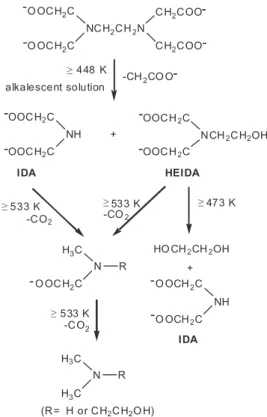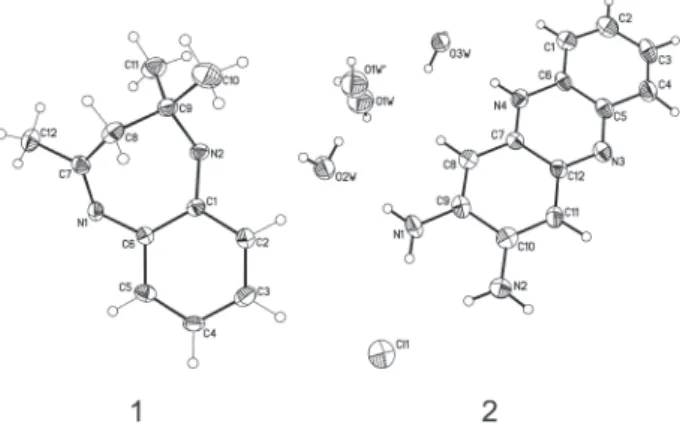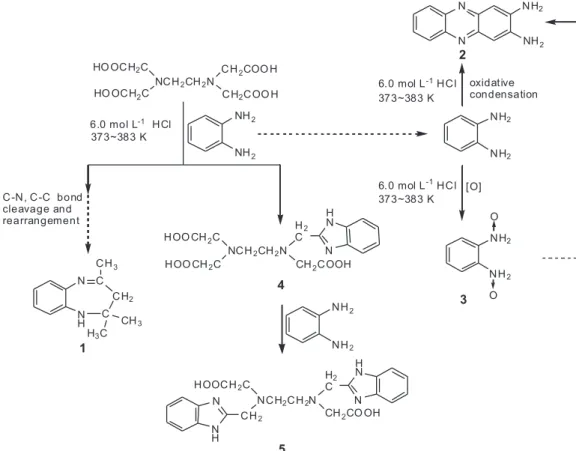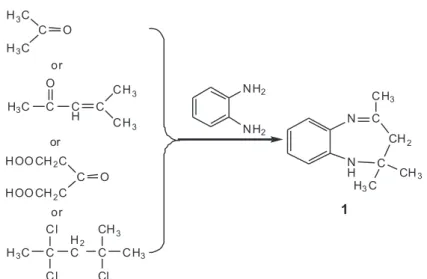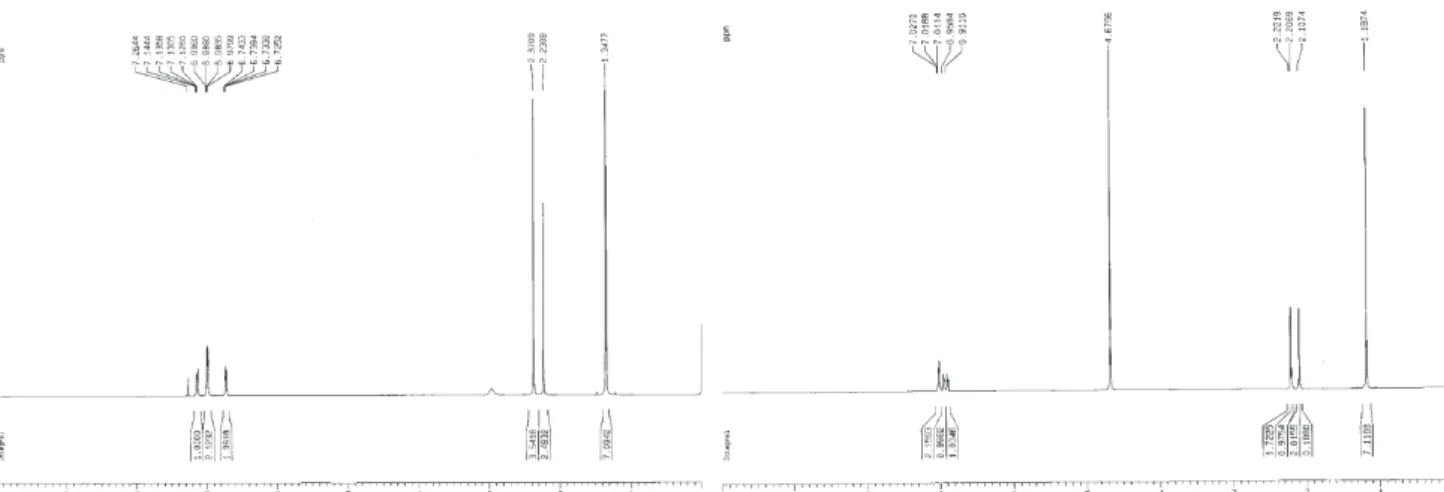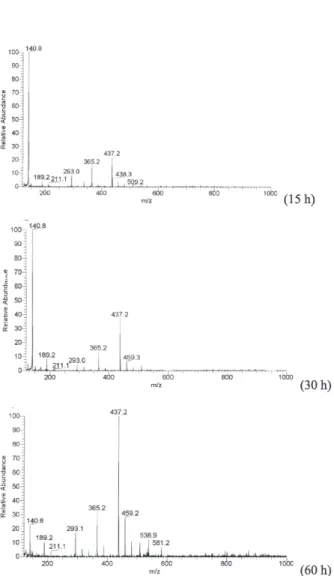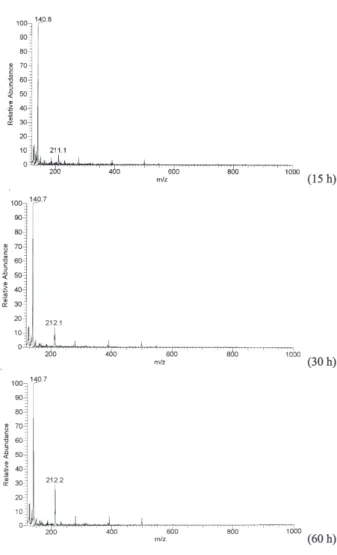0103 - 5053 $6.00+0.00
Article
*e-mail: boxwxy@nju.edu.cn
Thermal Decomposition of Ethylenediaminetetraacetic Acid in the Presence of
1,2-Phenylenediamine and Hydrochloric Acid
Jingwen Chen,a,b Jinhao Gaoc and Xiaoyong Wang*,a
a
State Key Laboratory of Pharmaceutical Biotechnology, School of Life Science, Nanjing University, Nanjing 210093, P. R. China
b
Yancheng Institute of Technology, Yancheng 214003, P. R. China
c
State Key Laboratory of Coordination Chemistry, Coordination Chemistry Institute, Nanjing University, Nanjing 210093, P. R. China
Considerando os produtos de reação do ácido etilenodiaminotetraacético (EDTA) com 1,2-fenilenodiamina (o-PDA), um novo processo para a decomposição térmica do EDTA é proposto.
O meio ácido forte e a presença de o-PDA facilitam a decomposição de EDTA, como evidenciado
pela temperatura relativamente baixa de reação. Em adição aos passos descritos na literatura, um processo de rearranjo está presente na reação de decomposição. Os intermediários rearranjados condensam com o-PDA, formando um inesperado composto biologicamente ativo
2,2,4-trimetil-3H-5-hidro-1,5-benzodiazepina, proporcionando a possibilidade de explorar um mecanismo de decomposição alternativo para este quelante amplamente utilizado.
Based on the reaction products of ethylenediaminetetraacetic acid (EDTA) with 1,2-phenylenediamine (o-PDA), a novel thermal decomposition pathway of EDTA is proposed. The
strong acidic medium and the presence of o-PDA facilitate the decomposition of EDTA as
evidenced by the relatively lower reaction temperature. In addition to the steps described in literatures, rearrangement process is involved in the decomposition reaction. The rearranged intermediates condense with o-PDA, forming an unexpected biologically active compound
2,2,4-trimethyl-3H-5-hydro-1,5-benzodiazepine, thus provides the possibility to explore an alternative decomposition mechanism for this widely used chelator.
Keywords: ethylenediaminetetraacetic acid, heterocycle, reaction mechanism, thermal decomposition, thermochemistry
Introduction
Ethylenediaminetetraacetic acid (EDTA) is one of the most extensively used chelating agents in chemistry, biochemistry, medicine, environmental sciences, and paper industry.1-6As a scavenger for metal oxides or a
stabilizer for metal ions, EDTA is also used at elevated temperatures to prevent scale deposits in high-pressure boilers or nuclear reactors owing to its thermal stability.7
Nevertheless, the behaviour of EDTA in waste water effluents8,9 and natural aquatic systems10 has incurred lots
of threats to the natural environment. EDTA not only increases the total nitrogen contents, but also remobilizes
most toxic heavy metals from solid matter into water solution and thus extends their biological life cycles.11
Hence, great attention has been paid to the study on decomposition mechanism12-17 and treatment technique18
for this aminopolycarboxylic acid complexing agent. Both EDTA and its disodium salt are stable to heat even at 423 K.19 EDTA begins to decompose at about 463
K and nearly 50% breaks down at 483 K in the presence of metal ions.12 Stepwise decarboxylations and hydrolysis
procedures of the ethylene C-N link of EDTA have been suggested by earlier researchers.13,14 As shown in Figure
1, the decomposition mode may differ greatly with temperature changes.14,15
when ammonia was used as a reaction medium and reactant in a high pH system, both ammonolysis and hydrolysis of EDTA occurred with the production of N-(2-aminoethyl) iminodiacetic acid, N-(2-hydroxyethyl)iminodiactic acid (HEIDA), and iminodiactic acid (IDA) over a temperature range of 418-448 K.16 Kinetic study of EDTA degradation
showed that EDTA decomposed quite rapidly at 463 K and pH 10.4 with kobs of 0.37 h-1 and a half-life of 1.9 h.17 However,
the detailed mechanism has not yet been fully elucidated and little is known about the decomposition of EDTA in acidic media.
We report herein the decomposition of EDTA in 6 mol L-1 hydrochloric acid aqueous solution in the presence
of 1,2-phenylenediamine (o-PDA) at 373 ~ 383 K. The
reaction provides some new insights into the decompo-sition mode of EDTA. The o-PDA seems to be able to
trap some of the decomposition intermediates, giving rise to the formation of a medically important compound, 2,2,4-trimethyl-3H-5-hydro-1,5-benzodiazepine.
Experimental
General
Elemental analyses were performed with a Perkin-Elmer 240C elemental analyzer. Infrared spectra (400-4000 cm-1)
were recorded on a Bruker VECTOR22 spectrophotometer
using KBr pellets. The 1H NMR spectra were obtained at
293 K on a Bruker DRX-500 spectrometer using standard pulse sequences. Electrospray mass spectra were recorded on a LCQ electron spray mass spectrometer (ES-MS, Finnigan) in a full scan range. Single-crystal X-ray diffraction measurement was carried out on an Enraf-Nonius CAD-4 diffractometer with ω/2θ scan mode. The data were corrected for Lorentz and polarization effects and the absorption correction were made using the psi-scan method. The crystal structures were solved by the SHELXTL software package.20
Crystallographic data have been deposited with Cambridge Crystallographic Data Centre. Deposition number for 2,2,4-trimethyl-3H-5-hydro-1,5-benzodiazepine (1) and 2,3-diamino-5-hydrophenazinium chloride trishydrate (2) are CCDC-229001 and CCDC-229002, respectively. Copies of the data can be obtained free of charge from the Cambridge Crystallographic Data Centre, 12, Union Road, Cambridge, CB2 1EZ, UK; Fax: +44 1223 336033; e-mail: deposit@ccdc.cam.ac.uk.
Reaction of EDTA with o-PDA
Under vigorous stirring, 372.2 mg (1.0 mmol) of EDTA-2Na was added to 50 mL of 6.0 mol L-1 hydrochloric acid
aqueous solution. The solution was heated to about 363 K till EDTA-2Na dissolved completely. To the resulting solution 432.8 mg (4.0 mmol) of o-PDA was added and allowed to
reflux at 373-383 K for 60 h. During the reaction, an aliquot of 0.2 mL solution was taken out every 3 h to monitor the reaction process by ES-MS. Dark green crystalline solid (I) was obtained from the reaction solution after standing overnight. Yellow precipitates (II) were formed after the pH of the mother liquor was adjusted to 6 ~ 7 with concentrated ammonia. The precipitates were dissolved in 25 mL of diethyl ether and the resulting suspension was filtered and the filtrate was dried on a rotatory evaporator to afford a yellowish crystalline solid that was identified as compound 1 (68 mg). Single crystals suitable for X-ray diffraction determination were obtained by slow evaporating the diethyl ether solution. The above dark green crystalline solid (I) was quickly washed with minimum amount of water and then fully with diethyl ether. The diethyl ether solution was dried to afford a dark solid, which was characterized as compound 2 (30 mg). The solid was then dissolved in methanol and dark needlelike single crystals suitable for X-ray diffraction determination were obtained after slow evaporation of the solvent.
The analytical data for compound 1 are as follows. IR (KBr) νmax/cm-1: 3296, 3083, 3061, 2964, 2954, 1633,
1594, 1514, 1476, 1432, 1381, 1374, 1323, 1307, 771. 1H
NMR (D2O, ppm): δ 7.03-6.91 (m, 4H, ph-H), 2.22-2.21 (d, 3H, -CH3), 2.11 (s, 2H, -CH2), 1.19 (s, 6H, -C(CH3)2); Figure 1. Different routes proposed for the decomposition of EDTA with
1H NMR (CDCl
3, ppm): δ 7.14-6.73 (4H, ph-H), 2.97 (1H,
-NH), 2.37 (3H, -CH3), 2.23 (2H, -CH2), 1.35 (6H, -C(CH3)2). ES-MS (positive ion mode): m/z = 189.2.
Elemental anal. calc. (found) for C12H16N2 (%): C, 76.55 (76.50); H, 8.57 (8.41); N, 14.88 (14.61). The analytical data for compound 2 are as follows. IR (KBr) νmax/cm-1:
3313, 3149, 1688, 1630, 1534, 1368, 1239, 1206, 771. 1H
NMR (D2O, ppm): δ 7.62-7.48 (4H, ph-H), 6.53-6.35 (2H,
o-amino-ph-H). ES-MS (positive ion mode): m/z = 211.1.
Control experiments were conducted under the same conditions as described above except that only EDTA-2Na (EDTA control) or o-PDA (o-PDA control) was
included as the reactant.
Results and Discussion
During the reaction of EDTA with o-PDA in 6.0 mol L-1
hydrochloric acid at 373-383 K, a gradual color change of the solution was observed within 2 h with pink appearing first, followed by orange, and eventually sustained dark green. The reaction was monitored by ES-MS technique (positive ion mode). When the reaction solution started to turn pink, a peak with m/z value of 140.7 was observed, which could
be attributed to one positively charged species 1,2-phenylenediamine-N, N-dioxide (3, C6H8N2O2, Calc. 140.14). The 1H NMR and IR data also confirmed this assignment.
The intensity of this peak decreased remarkably as the reaction time extended to ca. 40 h and nearly disappeared
when the reaction continued to 60 h. Compound 3 may further condense oxidatively forming 2,3-diaminophenazine (2, C12H10N4, Calc. 210.24), a known compound.21,22 The
observed color change from pink to dark green corresponds well to the species conversion from 3 to 2. Peaks with m/z
values of 365.2 and 437.2 appeared 5 h after the reaction started and their intensity increased gradually with time. Condensation of o-PDA with carboxylic acids to form
benzimidazoles is a conventional reaction.23 From the
synthesis of N, N, N’, N’-tetrakis-(2’-benzimidazolylmethyl)
-1,2-ethanediamine (EDTB) reported previously in the literature,24 the former peak was ascribed tentatively to one
positively charged N
-2-benzimidazolylmethyl-1,2-ethanediamine-trisacetic acid (4, C16H20N4O6, Calc. 364.36) and the latter to one positively charged N, N’
-bis(2-benzimidazolylmethyl)-1,2-ethanediamine-bisacetic acid (5, C22H24N6O4, Calc. 436.47). Compounds 4 and 5 may be the intermediates of the stepwise reaction of EDTA with o-PDA
to form EDTB. Compound 5 became the dominant product after 20 h reaction. The crystalline product with m/z = 211.2
was determined by the X-ray diffraction determination method and confirmed to be 2. The formation of compounds 2 and 3 appeared to be related only to o-PDA as illustrated
by the control experiment (vide infra). Figure 2 shows a
representative ES-MS spectrum detected with the reaction solution.
The most unexpected observation is that some 10 h after the beginning of the reaction, a new peak at 189.2 appeared in the ES-MS spectrum and its intensity increased gradually with time. Assisted by the 1H NMR,
IR, and elemental analyses, the peak was assigned to one positively charged 1 (C12H16N2, Calc. 188.3), also a known compound,25 which was further confirmed by X-ray
crystallography. The crystal structures and numbering schemes for 1 and 2 are shown in Figure 3.
From the structure of 1, it can be presumed that EDTA has taken part in the formation of this compound. To Figure 2. ES-MS spectrum detected with the reacting solution of EDTA and
o-PDA in the 6 mol L-1 hydrochloric acid at 373-383 K (40 h) (positive ion
mode). Attribution: 140.8, 1,2-phenylenediamine-N, N-dioxide; 189.2,
2,2,4-trimethyl-3H-5-hydro-1,5-benzodiazepine; 212.3, 2,3-diaminophenazine; 293.0, EDTA; 365.2, N-2-benzimidazolyl
methyl-1,2-ethanediamine-trisacetic acid; 437.2, N, N ’-bis(2-benzimidazolylmethyl)-1,2-ethanediamine-bisacetic acid; 459.3, N, N
’-bis(2-benzimidazolylmethyl)-1,2-ethanediamine-bisacetic acid monosodium salt; 581.2, EDTB.
validate this presumption, EDTA and o-PDA control
experiments were performed respectively. In the former experiment, only different forms of EDTA sodium salts and EDTA itself were detected in the ES-MS spectrum. The latter experiment was somewhat complex. The ES-MS spectrum showed a peak at 140.8 within one hour, which was attributed to 3 as mentioned above. This peak maintained, though decreased slightly, a considerable intensity till the end of the experiment (60 h). Another peak at 211.2 in the ES-MS spectrum is ascribed to 2 and its intensity increased significantly with time. No trace of 1 was found in both control experiments and thus its formation must be related to the decomposition of EDTA and the participation of o-PDA. Taken the above
experimental results together, a reaction pathway of EDTA with o-PDA in strong acidic solution at 373-383 K can be
summarized in Figure 4.
With o-PDA as a starting material, to form the
seven-membered ring in 1, the other reactant should be a six- or at least a three-carbon unit. However, in the starting materials, none has consecutive six- or three-carbon moieties besides o-PDA, thus the unit must come from
the decomposition intermediates of EDTA. Moreover, to generate such intermediates, rearrangement of the original decomposition fragments is indispensable. Therefore, it
can be inferred that in addition to the previously reported C-N and C-C bond cleavages, some amount of EDTA decomposition intermediates may undergo further rearrangement in the presence of o-PDA and hydrochloric
acid. Although the rearranged intermediates have not been directly detected in the EDTA decomposition, some potential fragments can still be proposed. It is reported that compound 1 could be prepared by condensation of
o-PDA with 4-methyl-3-penten-2-one,25 acetone,26-31
acetonedicarboxylic acid,32 or 2, 4,
4-trichloro-2-metyl-pentane33 under different conditions (Figure 5). These facts
suggest that the rearranged intermediates might be one or some of these reactants. o-PDA may play as a catcher to
prevent some rearranged unstable intermediates of EDTA such as acetone from escaping from the reaction system. We are currently unable to outline the exact mechanism for such steps.
The chemical bond energies of C-N, C-O, C-C, C-H, O-H and C=O in EDTA are 276, 331, 339, 410, 456 and 724 KJ mol-1, respectively.34 Therefore, C-N, C-O, and
C-C bonds are relatively weaker than other bonds and could be cleaved more easily at certain temperature. The strong acidity coupled with o-PDA somewhat decreased
the thermal stability of EDTA and render it decompose at temperatures just above the boiling point of water. o-PDA
plays a pivotal role in the decomposition process because control experiment indicated that EDTA alone is stable in 6.0 mol L-1 hydrochloric acid solution at 373-383 K.
The benzodiazepines are a class of compounds with wide biological and pharmaceutical properties35-37 and are
valuable scaffolds for the preparation of some fused ring benzodiazepine derivatives.38-42 Several methods for
preparing these compounds have been reported in the literature.25-32 To our knowledge, the formation of the
1,5-benzodiazepine skeleton by the reaction of EDTA with
o-PDA in strong acidic medium has not been reported so
far. Although this reaction may not be an economic route for the preparation of compound 1, it helps us to sketch a new potential thermal decomposition mechanism for EDTA.
Conclusions
The present study shows that the presence of o-PDA
and strong acidic environment facilitate the thermal decomposition of EDTA at moderately lower temperature. The decomposed fragments of EDTA may undergo a rearrangement process and then react with o-PDA, giving
rise to the formation of 2, 2, 4-trimethyl-3H-5-hydro-1, 5-benzodiazepine. These unexpected findings suggest that an alternative pathway for EDTA decompsiton may exist under certain special conditions and this concealed property may cause some uncommon events when EDTA be used in strong acidic medium.
Supplementary Information
The 1H NMR and ES-MS spectra for compounds
characterization, and the ES-MS spectra for monitoring the reactions of EDTA with o-PDA in acidic media are available
free of charge at http://jbcs.sbq.org.br, as PDF file.
Acknowledgments
We thank the financial support from the National Natural Science Foundation of China (No.s 29925102, 20231010 and 20228102).
References
1. Pribil, R.; Analytical Applications of EDTA and Related Compounds, Pergamon Press: Oxford, 1972, p. 260.
2. Pribil, R.; Applied Complexometry, Pergamon Press: Oxford,
1982.
3. Iwahara, J.; Anderson, D. E.; Murphy, E. C.; Clore, G. M.; J. Am. Chem. Soc.2003, 125, 6634.
4. Ernst, E.; Circulation1997, 96, 1031.
5. Alder, A. C.; Siegrist, H.; Gujier, W.; Giger, W.; Water Res. 1990, 24, 733.
6. Lapierre, L.; Bouchard, J.; Berry R. M.; Van Lierop, B.; J. Pulp Pap. Sci.1995, 21, 268.
7. Rufus, A. L.; Sathyaseelan, V. S.; Srinivasan, M. P.; Padma, S. K.; Veena, S. N.; Velmurugan, S.; Narasimhan, S.V.; Prog. Nucl. Energy2001, 39, 285.
8. Sillanpää, M.; Chemosphere1996, 33, 239.
9. Kari, F. G.; Giger, W.; Water Res.1996, 30, 122.
10. Sillanpää, M.; Rev. Environ. Contam. Toxicol.1997, 152, 85.
11. Li, Z.; Schuman, L. M.; Soil Sci.1996, 161, 226.
12 Venezky, D. L.; Rudzinski, W. E.; Anal. Chem. 1984, 56,
315.
13. Venezky, D. L.; Moniz, W. B.; Anal. Chem.1969, 41, 11.
14. Sniegowski, P. J.; Venezky, D. L.; J. Chromatogr. Sci.1974,
12, 359.
15. Martell, A. E.; Motekaitis, R. J.; Fried, A. R.; Wilson, J. S.; MacMillan, D. T.; Can. J. Chem.1975, 53, 3471.
16. Motekaitis, R. J.; Hayes, D.; Martell, A. E.; Frenier, W. W.;
Can. J. Chem. 1979, 57, 1018.
17. Motekaitis, R. J.; Cox III, X. B.; Taylor, P.; Martell, A. E.; Miles, B.; Tory J. Tvedt, Jr.; Can. J. Chem.1982, 60, 1207.
18. Sillanpää, M.; Pirkanniemi, K.; Environ. Technol.2001, 22,
791.
19. Blaedel, W. J.; Knight, H. T.; Anal. Chem. 1954, 26, 4, 741.
20. Sheldrick, G. M.; SHELXTL, Structure Determination Software Programs, Version 5.10, Bruker Analytical X-ray Systems Inc.:
Madison, USA, 1997.
21. Nogami, T.; Hishida, T.; Yamada, M.; Mikawa, H.; Shirota, Y.;
Bull. Chem. Soc. Jpn.1975, 48, 3709.
22. Brownstein, S. K.; Enright, G. D.; Acta Cryst. C51, 1995, 1579. 23. Phillips, M. A.; J. Chem. Soc.1928, 172, 2393.
24. Hendriks, H. M. J.; Briker, J. M. W. L.; van Rijn, J.; Verschoor, G. C.; Reedijk, J.; J. Am. Chem. Soc.1982, 104, 3607.
25. Morales, H. R.; Bulbarela, A.; Contreras, R.; Heterocycles1986,
24, 135.
26. Curini, M.; Epifano, F.; Marcotullio, M. C.; Rosati, O.;
Tetrahedron Lett.2001, 42, 3193.
27. Balakrishna, M. S.; Kaboudin, B.; Tetrahedron Lett.2001, 42,
1127.
28. Kaboudin, B.; Navaee, K.; Heterocycles2001, 55, 1443.
29. Pozarentzi, M.; Stephanidou-Stephanatou, J.; Tsoleridis, C. A.;
Tetrahedron Lett.2002, 43, 1755.
30. Jarikote, D. V.; Siddiqui, S. A.; Rajagopal, R.; Daniel, T.; Lahoti, R. J.; Srinivasan, K. V.; Tetrahedron Lett.2003, 44, 1835.
31. Reddy, B. M.; Sreekanth, P. M.; Tetrahedron Lett.2003, 44,
4447.
32. Jung, Dai-II; Choi, T. W.; Kim, Y. Y.; Kim, In-S.; Park, Y. M.; Lee, Y. G.; Jung, D. H.; Synthetic Commun.1999, 29, 1941.
33. Redshaw, C.; Wilkinson, G.; Hussain-Bates, B.; Hursthouse, M. B.; J. Chem. Soc., Dalton Trans.1992, 555.
34. Carey, F. A.; Sundberg, R. J.; Advanced Organic Chemistry,
Plenum Press: New York, 1990.
35. Sternbach, L. H.; Angew. Chem., Int. Ed.1971, 10, 34.
36. Smalley, R. K.; Comprehensive Organic Chemistry, Barton,
D.; Ollis, W. D., eds.; Pergamon Press: Oxford, 1979, vol. 4, p. 600.
37. Castle, R. N.; Phillips, S. D.; Comprehensive Heterocyclic Chemistry, Katritzky, A. R.; Rees, C. W.; Boulton, A. J.;
McKillop, A., eds.; Pergamon Press: Oxford, 1984, vol. 1, pp. 166, 170.
38. Chimirri, A.; Grasso, S.; Ottana, R.; Romeo, G.; Zappala, M.;
J. Heterocyclic Chem. 1990, 27, 371.
39. Aatif, A.; Baouid, A.; Benharref, A.; Hasnaoui, A.; Synthetic Commun.2000, 30, 2647.
40. Elhazazi, S.; Baouid, A.; Hasnaoui, A.; Compain, P.; Synthetic Commun.2003, 33, 19.
41. Prakash, O.; Kumar, A.; Sadana, A.; Singh, S. P.; Synthetic Commun.2002, 32, 2663.
42. Rao, P. S.; Venkataratnam, R. V.; Synthetic Commun.1991, 21,
1811.
Received: November 11, 2005
0103 - 5053 $6.00+0.00
Supplementary Information
*e-mail: boxwxy@nju.edu.cn
Thermal Decomposition of Ethylenediaminetetraacetic Acid in the Presence of
1,2-Phenylenediamine and Hydrochloric Acid
Jingwen Chen,a,b Jinhao Gaoc and Xiaoyong Wang*,a
a
State Key Laboratory of Pharmaceutical Biotechnology, School of Life Science and Nanjing University, Nanjing 210093, P. R. China
b
Yancheng Institute of Technology, Yancheng 214003, P. R. China
c
State Key Laboratory of Coordination Chemistry, Coordination Chemistry Institute, Nanjing University, Nanjing 210093, P. R. China
Figure S1. ES-MS spectrum of compound 1.
Figure S2.1H NMR spectra of compound 1 in CDCl
Figure S4.1H NMR (D
2O) spectrum of compound 2.
Figure S5. ES-MS spectrum of compound 3.
Figure S7. ES-MS spectra detected with the reacting solution of EDTA and o-PDA in the 6 mol L-1 hydrochloric acid at 373-383 K (15 h, 30 h,
and 60 h).
Figure S3. ES-MS spectrum of compound 2. Figure S6.1HNMR (D
Figure S8. ES-MS spectra detected with the solution of EDTA in the 6
mol L-1 hydrochloric acid at 373-383 K (15 h, 30 h, and 60 h). Figure S9. ES-MS spectra detected with the solution of o-PDA in the 6
